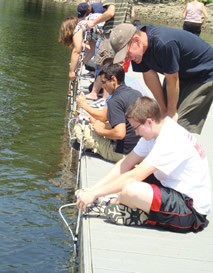Natural Detection
Water-quality sensors build STEM skills and environmental stewardship among whiz kids and struggling students alike.
BY LIESL HOTALING
Sensors are everywhere, from motion-detector light switches to pollution monitors. When used in environmental research projects, they offer a highly engaging, interdisciplinary approach to teaching middle and high school students a multitude of science, technology, engineering, and math (STEM) subjects and skills.
To provide the kind of hands-on, collaborative experiences that lend themselves to sustained inquiry and mastery, we developed a sensor network for water-quality monitoring. The Student Enabled Network of Sensors for the Environment using Innovative Technology, or SENSE IT program, integrates fundamental STEM principles while introducing sensors and technology in the context of protecting the Hudson and St. Lawrence rivers. We then trained 60 teachers to use the equipment and implement a set of carefully crafted curriculum modules tied to state and national science, technology, and math standards. Over the course of two years, some 1,700 students in three regions—rural, urban, and suburban—built, calibrated, and tested a set of sensors and circuits designed to measure water temperature, conductivity, turbidity, and depth.
To build and understand their sensors, students use a wide range of core knowledge of mathematics and physical science. They also learn such practical, hands-on technology skills as soldering and debugging circuits. (The sensors are constructed from scratch using standard off-the-shelf electronics components.)
Students are led through the physics principles, circuitry, and mathematical analysis required to build each sensor, with the aim of demystifying the “black box” effect associated with using commercially available probes in classrooms. They then interface their sensors with computers, write programs to gather raw signals, implement calibration curves, and perform data manipulation and data logging. In addition, students can program their own communications protocols for wireless transmission of the sensor data, and connect their computerized sensor stations to form a distributed wireless sensor network.
Tracked implementation of SENSE IT in classrooms demonstrates that, although additional time and effort are required, it is possible to have students carry out complex problem-based, hands-on projects within the scope of existing standard curricula tied to state and national learning standards. The applied themes of environmental stewardship and sensor networks provide 1) a motivating and meaningful scenario for learning a wide range of core math, science, and technology topics and workforce readiness skills; 2) an awareness of the ubiquity of sensors in our world and the link between the biological, physical, and social sciences, 3) a means to encourage learners to look at local water quality and environmental issues and data from a global perspective; and 4) an opportunity for students to learn about potential careers involved with environmental monitoring and management.
Participating teachers are positive about the benefits of SENSE IT, both in terms of engagement and what students learn. Their responses indicate that successful integration of SENSE IT is due to the flexibility of the curriculum to fit into existing courses and to meet students’ wide-ranging academic levels, from upper-level high school students to middle school students, and from Advanced Placement to courses for students unable to qualify for higher-level science. The research results suggest that participating in SENSE IT led to higher scores on post-tests evaluating algebraic and electrical circuit knowledge for all but the more affluent and academically strong high school students. SENSE IT participation particularly benefited students in low-income schools and weaker students in all schools.
Students also gave SENSE IT high marks. Using a rating scale from A to F, 85 percent of high school students gave it an A or B for enjoyment and about 75 percent awarded an A or B for learning. Over 98 percent of middle school students gave it an A or B for learning and 80 percent for enjoyment. High school students liked the hands-on aspects of the project best, while middle school students liked building and working in groups.
We hope to continue to expand SENSE IT materials, increase the numbers of teachers and pupils exposed to hands-on learning experiences that revolve around sensors, and prepare students for the complex, multidisciplinary challenges awaiting them in today’s technology-focused workplace.
Liesl Hotaling is senior research engineer at the University of South Florida and president of Eidos Education. This is excerpted from “SENSE IT: Teaching principles to middle and high school students through the design, construction and deployment of water quality sensors” in the Summer 2012 Advances in Engineering Education. Coauthors of the original article are Susan Lowes and Peiyi Lin, Teachers College, Columbia University; Rustam Stolkin, University of Birmingham, U.K.; and James Bonner, William Kirkey, and Temitope Ojo, Clarkson University. Learn more about the SENSE IT project at http://www.senseit.org/. Supported by National Science Foundation NSF ITEST award 0833440
Category: Advances From Aee
